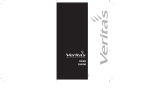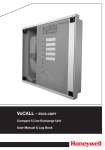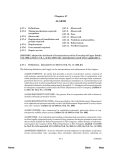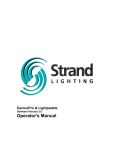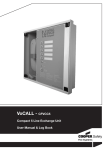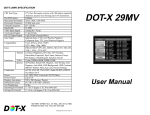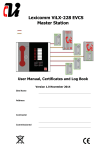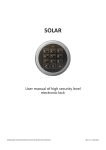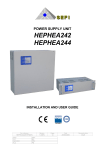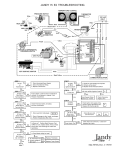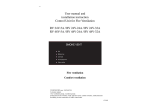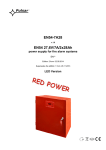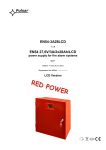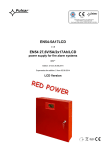Download svcs-1 cover.ai - Window Openers Direct
Transcript
hiGhLiNe WINDOW CONTROLS INSTALLATION & USER MANUAL SMOKE VENT CONTROL SYSTEM * enclosure design may vary SVCS-1 software version: SVCS1r6 SVCS1r7 SVCS1r10 CERTIFICATE OF COMPLIANCE – SVCS-1 We the undersigned confirm that the SVCS-1 Simplified Ventilation Control Panel conforms to relevant standards of construction and is fit for purpose, which is, the control of automatic ventilation of habitable areas when smoke is present in those areas. Signed for and on behalf of Smoke Control Systems Ltd. Ian Walton............................................. Date: 04/01/2012 EQUIPMENT CONSTRUCTION STANDARDS All control panels that we supply comply with the following harmonised directives. EN12101-10 Power Supplies EMC (Electro-Magnetic Compatibility directive) Specifically EN55014 EN50130 LVD (Low Voltage Directive) We also use the applicable parts of BS5839 and EN54-2 (self declaration method) for the design basis of our control equipment. Other directives are still in the consultative stage and as yet are not fully harmonised with regard to smoke control equipment. CONTENTS General Overview / Operation 3 Function 4 Installation 5 Cabling 6 Wiring Schematic 7 Connecting Actuator / Fire Alarm / Break Glass 8 Connecting Firemans Override 9 Connecting Smoke Sensors 10 Battery Information 11 Connecting Batteries / Mains Supply 12 Connections Overview 13 Testing 14 Fault Finding 17 Maintenance 18 Maintenance Schedule 19 SVCS-1 - USER MANUAL (version 2012) 2 GENERAL OVERVIEW The SVCS series of smoke vent systems are easy to operate, need very little maintenance and are "intelligent", in that for most common failures (wiring, power supplies etc.) they will set some form of warning alarm. OPERATION Once fully installed the system is totally automatic and provided that the Red LED indicator is not on and there are no warning sounds the system will upon receipt of an alarm input condition (BMS Fire Alarm etc) open the smoke vents. The smoke vents will stay fully open until the input condition (BMS, Fire Alarm, etc) has been normalized, when the vents will close. Should you require the vents to stay open after the alarm panel has been silenced (or deactivated) then a manual open command should be issued by use of the manual key switch on the front panel. TECHNICAL SPECIFICATION Supply Voltage Output Voltage Output Current SVCS-1 - USER MANUAL (version 2012) 230v AC 24v DC 2-10A 3 FUNCTION PANEL KEYSWITCH – TOP PRIORITY OPEN All vents will open even if smoke sensor or break glass call points are not activated. AUTO Will obey any remote inputs. CLOSE Will close vents even if smoke sensor or break glass call points are activated. FIREMANS OVERRIDE SWITCH – TOP PRIORITY OPEN All vents will open even if smoke sensor or break glass call points are not activated. AUTO Will obey any remote inputs. CLOSE Will close vents even if smoke sensor or break glass call points are activated. Note: There is no priority between the keyswitches but a close (can be set to open by special order) signal will take priority SMOKE SENSOR – 2ND PRIORITY ACTIVATED All vents will open unless overridden by FIREMANS OVERRIDE or CONTROL PANEL SWITCH. NOT ACTIVATED Vents stay closed. BREAK GLASS – 2ND PRIORITY ACTIVATED All Vents will open unless overridden by FIREMANS OVERRIDE or CONTROL PANEL SWITCH. NOT ACTIVATED Vents stay closed. POWER FAILURE PROCEDURE ON POWER FAILURE Immediately ACTION Report fault. After 11 hours Opens Vents & shuts down to minimum power. After 72 hours System failure batteries may not power system back up. SVCS-1 - USER MANUAL (version 2012) RESULT Report fault bleep and red light every 4 secs. Manual override of vents by firemans override switch only reports fault by red light every 10 secs. No audible fault indicator. Manual override of vents may not be achievable & batteries may need replacing. 4 INSTALLATION 1 Unlock enclosure door using key provided. 2 Prepare holes or use pre-prepared knock outs for cable entry. Fit cable glands (by others). Fix cabinet in place (fixings by others). 3 Feed cables into cabinet. 4 Make cable connections as per attached wiring diagrams (Make mains connection but do not turn on or connect batteries until final checks are completed). 5 Ensure Cabinet is earthed (test using low value ohms meter). 6 Connect blue connector (found on back of enclosure door) to control board. SVCS-1 - USER MANUAL (version 2012) 5 CABLING Cabling of this panel should only be carried out by a competent person and in accordance with all local and national standards and legislation. MAINS VOLTAGE Two core + earth on a fused 3 amp spur or a separate circuit protected by a 6amp MCB VENT ACTUATORS Two core + earth FP200 or equivalent for reverse polarity actuators Three core + earth FP200 or equivalent for common with drive open- drive close Three core + earth FP200 or equivalent for Belimo Actuators Some actuators have a signal wire to indicate open close status this MUST NOT be connected to the panel Cable sizes must be calculated to ensure against excessive voltage drop Voltage Drop (Vd) should not exceed 2 Volts The formula is as follows; Vd = mV x A x m Where; A = total amperage of motors m = length in metres mV= millivolts per amp per metre figure taken from manufacturers cable data or use the tables in the BS7671 (wiring regs.) document. Example; 1 Supermaster Actuator = 2 Amps max load Cable length m = 20 metres 1.5mm square cable == 29mV per amp per metre == 0.029Volts (0.029 x 2) x 20 = 1.16V (Vd) The above result is well within the limit of a 2 Volt voltage drop. SVCS-1 - USER MANUAL (version 2012) 6 WIRING SCHEMATIC HEALTHY FAULT AUTO OPEN HEALTHY Green steady CLOSE Power On, System OK FAULT 1 Bleep 4 sec interval Flashes Green to Red Power Off, batteries healthy 3 Bleeps & Flashes Green to Red Battery set 1 low disconnected or FS3 Blown 4 Bleeps & Flashes Green to Red Battery set 2 low disconnected or FS3 Blown Continuous Sound Activated Rapid 2 tone Firemans override operated SVCS-1 VCS-S1 SMOKE VENT CONTROL SYSTEM SVCS-1 SMOKE SENSOR SOUNDER (SSS) ACTUATOR SMOKE SENSOR (SSR) ** WIND SENSOR (WS1) FIREMANS OVERRIDE (BG2/FOS) HEALTHY FAULT AUTO OPEN HEALTHY Green steady CLOSE Power On, System OK FAULT 1 Bleep 4 sec interval Flashes Green to Red Power Off, batteries healthy 3 Bleeps & Flashes Green to Red Battery set 1 low disconnected or FS3 Blown 4 Bleeps & Flashes Green to Red Battery set 2 low disconnected or FS3 Blown Continuous Sound Activated Rapid 2 tone Firemans override operated ** RAIN SENSOR (RS1) BREAK GLASS CALL POINT (BG1/S) SVCS-1 VCS-S1 ** THERMOSTAT (TS1) 230V AC FUSED SPUR 2-CORE 3-CORE 4-CORE SVCS-1 - USER MANUAL SMOKE VENT CONTROL SYSTEM FIREMANS OVERRIDE (BG1/FOS) FIRE ALARM SIGNAL (VOLT FREE) NOTE CABLE SIZE MUST BE CALCULATED TO ENSURE VOLTAGE DROP DOES NOT EXCEED 2V AT ALL MOTORS FULL LOAD ** AVAILABLE ONLY WITH A MODIFIED SVCS-1 CONTROL BOARD. DESIGNED FOR NATURAL VENTILATION. 7 CONNECTING ACTUATOR(S) CONNECTING BREAK GLASS CONNECTING TO A FIRE ALARM SVCS-1 - USER MANUAL (version 2012) 8 CONNECTING FIREMANS OVERRIDE KEYSWITCH CONNECTING FIREMANS OVERRIDE SWITCH SVCS-1 - USER MANUAL (version 2012) 9 CONNECTING SMOKE SENSOR(S) SVCS-1 - USER MANUAL (version 2012) 10 GENERAL BATTERY SET(S) Note: When batteries are changed, the battery charger should be checked for voltage, which should read approx. 27.6V, if different, please contact supplier. VOLTAGE 27.6 Float Charge Voltage 25-27.6 U3 Warm to hot 22.1-24.9 U3 Warm to hot 21-22 U3 Warm to hot 14-21.9 May need replacing <14 WILL NEED REPLACING STATE Batteries trickle Charging fully charged Batteries Charging + 50 – 95% charged Batteries Charging + 10 - 49% charged Batteries Charging + <10% charged Batteries Charging + <5% charged Batteries Charging + <5% charged The above is a guide only to the charge state of the batteries. There are a number of conditions that can occur in the chemistry of batteries that can give erroneous indications by using simple voltage measurement techniques. The only sure way of testing capacity is with a known load over time and tracking the battery voltage over this time. If the batteries have been abused by discharging them to totally flat and kept in that condition for an extended period it is better to replace them as they are likely to be damaged and therefore may have a much reduced capacity SVCS-1 - USER MANUAL (version 2012) 11 SINGLE SET – 2AMP LOAD SINGLE SET – 10AMP LOAD CONNECTING THE MAINS SVCS-1 - USER MANUAL (version 2012) 12 OVERVIEW Note: References to earthing of the cabinet refer to made to order panels only that are using a metal cabinet. SVCS-1 - USER MANUAL (version 2012) 13 TESTING By far the most important thing about the use of this type of equipment is REGULAR TESTING! Testing has two major functions. A The smoke sensors, alarm panel and vents are fully tested. B Like all mechanical equipment the Vent Actuator motors need to be used periodically so as to help prevent the build-up of internal corrosion and the likelihood of an associated seizure of the mechanical parts. Weekly visual (5 minutes) Go to the panel and check for any warning/fault indications. If there is a fault then call your local electrical engineer or call your supplier who will be pleased to help you. Monthly test (15 minutes) The Full Alarm testing should be carried out with the use of a "Smoke Aerosol". A 5 to 10 second spray at one of the smoke sensors will set off the alarm system. Each month choose a different smoke sensor. Whilst the alarm is active check that all Vents are open (Note ; in accordance with your cause and effect chart), reset the alarm condition (you may have to do this a couple of times if the sensor under test has not cleared the "smoke"). Next check that the manual key-switch will OPEN the Vents (if fitted). After this switch back to AUTO, check again that there no fault conditions and that concludes the test. Annual Once a year a full battery discharge test is advisable to check the condition of the secondary power supply so that in the event of a fire the firemen have sufficient open and close cycles available for their use. This should be done by a specialist. Call your supplier for further information about annual service contracts. Log The following are guidance notes around the mandatory maintenance and testing requirements for both powered and natural smoke ventilation systems. THE REGULATORY REFORM (FIRE SAFETY) ORDER 2005 states: Maintenance 17:- (1) Where necessary in order to safeguard the safety of relevant persons the responsible person must ensure that the premises and any facilities, equipment and devices provided in respect of the premises under this Order or, subject to paragraph (6), under any other enactment, including any enactment repealed or revoked by this Order, are subject to a suitable system of maintenance and are maintained in an efficient state, in efficient working order and in good repair. BRITISH STANDARD BS 9999:2008 states: Annex V (normative) Routine inspection and maintenance of fire safety installations SVCS-1 - USER MANUAL (version 2012) 14 V.1 General NOTE Fire safety installations comprise the items and elements of which examples are listed in Annex J. It is essential for the safety of the occupants of a building that fire safety equipment (including passive fire protection provisions) is inspected frequently. Although much of the inspection can be undertaken by suitably trained personnel, a formal agreement should be made with the installer or the installer’s representative to provide the regular inspection and testing described in the relevant British Standards for individual fire safety installations. Unless temporary alternative fire safety systems can be put in place, it might be appropriate for certain of the inspections carried out at three monthly or longer intervals to be done outside normal working hours. V.2 Daily inspections V.2.1 General The checks described in V.2.2 to V.2.6 should be undertaken daily. For premises with defined opening times such as shops, theatres and cinemas, these checks should be undertaken prior to members of the public entering the building. V.2.2 Fire detection and alarm systems N/A V.2.4 Sprinkler systems N/A V.2.5 Fire door automatic release mechanisms N/A V.2.6 Portable fire extinguishers and hose reels N/A V.3 Weekly V.3.1 General In addition to the checks recommended in V.2, the checks described in V.3.3 to V.3.7 should be undertaken once a week. V.3.2 Fire detection and alarm systems N/A V.3.3 Sprinkler systems N/A V.3.4 Gaseous, foam and powder extinguishing systems N/A V.3.5 Smoke control systems for means of escape Actuation of the system should be simulated once a week. It should be ensured that any fans and powered exhaust ventilators operate correctly, smoke dampers close (or open in some systems), natural exhaust ventilators open, automatic smoke curtains move into position, etc. V.3.6 Evacuation lifts and fire-fighting lift installations N/A V.3.7 Fire hydrants N/A V.4 Monthly V.4.1 General In addition to the checks recommended in V.2 and V.3, the checks described in V.4.2 to V.4.9 should be undertaken once a month. V.4.2 Fire detection and alarm systems N/A V.4.3 Emergency and escape lighting systems N/A V.4.4 Gaseous, foam and powder extinguishing systems N/A V.4.5 Evacuation lifts and fire-fighting lift installations N/A V.4.6 Hose reels N/A V.4.7 Automatic opening doors N/A V.4.8 Doors on hold-open devices N/A V.4.9 Emergency and panic escape doors N/A SVCS-1 - USER MANUAL (version 2012) 15 V.5 Three-monthly In addition to the checks recommended in V.2, V.3 and V.4, the actuation of all smoke control systems should be simulated once every three months. All zones should be separately tested and it should be ensured that any fans and powered exhaust ventilators operate correctly, smoke dampers close (or open in some systems), etc. V.6 Six-monthly V.6.1 General In addition to the checks recommended in V.2, V.3, V.4 and V.5, the checks described in V.6.2 and V.6.3 should be undertaken once every six months. Arrangements should be made for six- monthly inspections and tests to be carried out by competent persons on the fire detection and alarm systems, the sprinkler systems, any extinguishing systems, the emergency and escape lighting systems and the fire-fighting lift, for any defects found to be logged and the necessary action taken, and for certificates of testing to be obtained. V.6.2 Fire doors N/A V.6.3 Fire mains N/A V.7 Yearly NOTE Attention is drawn to the testing and inspection requirements of BS 7671. In addition to the checks recommended in V.2, V.3, V.4, V.5 and V.6, arrangements should be made for annual inspections and tests of the following to be carried out by competent persons, for any defects to be logged and the necessary action taken, and for certificates of testing to be obtained: . d) smoke ventilators and smoke control systems; Whilst this is a comprehensive assessment (and is for general guidance only), it should be noted that manufacturers have their own maintenance and testing requirements and if different these should be followed. For full guidance you should read the Regulatory Reform Order 2005 along with BS9999 to satisfy that you are meeting your statutory obligations. SVCS-1 - USER MANUAL (version 2012) 16 FAULT FINDING FAULT INDICATOR One bleep at four second interval Rapid 2 tone Two x 2 tone Three bleeps @ two second interval Four bleeps @ two second interval Continuous sound FAULT Mains Power failure or FS1 blown (315mA T) Override switch activated (open – close) Terminating resistor or FS4 blown (125mA T) Battery set 1 low or FS3 blown (10A T) Battery set 2 low or FS2 blown (10A T) Break glass or Smoke Sensor activated Red LED will be illuminated during each fault also the fault/reset relay will be active allowing the fault to be monitored remotely. SVCS-1 - USER MANUAL (version 2012) 17 MAINTENANCE CONTROL PANEL Control Panel should be maintenance free with the exception of the Batteries. BATTERIES Between 3 to 5 years the backup batteries will need to be changed. SENSORS, SWITCHES & ACTUATORS Refer to individual instructions for any attached components of this system. If you are in any doubt about any of the above procedures etc. then do give us a call and we will help you. SVCS-1 - USER MANUAL (version 2012) 18 MAINTENANCE SCHEDULE DATE WORK DONE COMPANY INITIALS SIGNATURE The above testing should be entered into a log with the sensor number (or floor level), date of testing and signed. The log should be kept in a safe place near the main control panel so any maintenance may be recorded. These are purely our recommendations and we would advise you contact your local fire officer who will only be too pleased to analyse the building and give his own recommendations as to testing and safety etc. Please use table on back page of this booklet and leave in or by the control panel. SVCS-1 - USER MANUAL (version 2012) 19




















